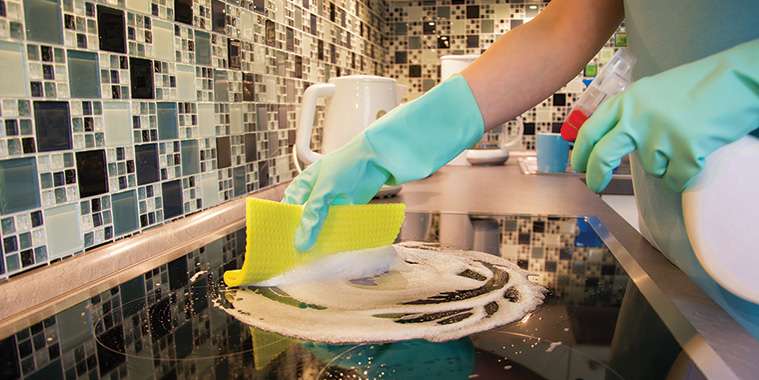Learning how to clean a kitchen might not seem like rocket science, but it’s definitely a lost art — something previous generations of homemakers obsessed over. We’re not saying you should remain tethered to a mop and bucket, but given the heavy foot traffic this area gets — not to mention all the food passing through — learning the right way to keep dirt, grime, and germs at bay is truly an essential part of owning a home.
So if you want to do this much-loved area justice, heed this list of tips on how to clean a kitchen right, broken down by areas that need some special attention. Adhering to these guidelines ensures your kitchen will look its best so you can impress your guests and maybe (just maybe) make your parents proud. It’s never too late.
How to clean kitchen cabinets
You want to begin by cleaning the cabinets. Why? Because no matter what room it is you’re cleaning, you always go from top to bottom. If you don’t, you’re going to undo some of your work by brushing dirt onto the lower surfaces.”
To clean wood cabinets, experts recommend using a microfiber cloth dipped in Murphy’s Oil Soap. For all other finishes, use a mild, nontoxic all-purpose cleaner. Pay special attention to door handles, which tend to accumulate the most germs.
When you’re finished, go over wood with Old English Scratch Cover polish. It works miracles on cabinets that are overdue for refinishing.
How to clean a microwave
The microwave is one of the most neglected kitchen appliances, which is why you might silently cringe when you open it to see the spatter of past dinners inside. The good news is that the magic box is usually quite easy to clean.
Jan Dougherty, author of “The Lost Art of House Cleaning,” recommends that you pop in a clean wet rag, run the microwave on high for 2 minutes, and let the rag sit for 20 minutes.
“The steam from the rag will soften up any hard-crusted foods so you can wipe it right off,” says Dougherty. If the microwave has a rotating glass tray, simply pop it in the dishwasher.
How to clean a kitchen stove
If your range has a gas cooktop, start by removing the grates and burner covers. Pour a quarter of a cup of household ammonia into a large gallon-size bag, then put the grate inside, seal it tight, and let the grate soak for 24 hours. Flip the bag six to eight times throughout the day. Within 24 hours, the grime will slide off.
While the grates are soaking, wipe the burner top with hot soapy water and a plastic scrub pad — but stay away from steel wool and abrasive cleaners, which can scratch the surface.
Have an electric range or cooktop? Wipe it down with hot soapy water, then polish using a formulated cooktop cleaner, like Cerama Bryte.
As for the oven, that’s the fun part — that is, if you have a fancy self-cleaning oven. If you don’t, place a pot of boiling water on the bottom rack and, on the top, a heat-safe bowl containing 1 cup of ammonia. Shut the oven door and leave overnight. By morning, the grease caking your oven’s insides will wipe right off (make sure to use rubber gloves).
How to clean a refrigerator
For starters, follow the top-to-bottom rule when you clean the shelves with a damp cloth and all-purpose cleaner. Next, here’s the step people forget: Wipe down the jars and other containers before you place them back inside, because the goop caked on them will rub off on your fridge’s interior.
You’ll also want to take out your vacuum and clean the refrigerator coils (which sit along the bottom or back of your fridge), which can collect dust and hamper your fridge’s performance.
How to clean kitchen countertops
For laminate or quartz countertops, use a soft cloth to wipe with a mild liquid detergent. Granite countertops, however, are a totally different beast, because food, grease, and wine can seep into granite if it isn’t properly sealed. To assess what condition your granite is in, drop a bit of water on the surface. If it beads up, you’re good. But if the water pools together, it’s time to reseal with granite sealant, which is available at any home improvement store.
Once the granite is protected again, make sure to wipe up spills as they happen to keep it in tiptop shape.
How to clean a dishwasher
This might sound strange — after all, isn’t the whole point of having a dishwasher so that you don’t have to clean as many things? — but you’ve probably noticed that even an empty dishwasher can get funky sometimes. That’s because food gets trapped in a strainer that’s in the bottom of the unit, which “creates a horrible odor.” Thus, you’ll want to remove the strainer (usually it twists right off) and clean it once every three months; to access it, simply pull out the bottom rack.
To clean the rest of the dishwasher, pour a bowl full of white vinegar, set it face up on the top rack, and run the dishwasher without anything else in it. The vinegar will circulate and clean everything.
— realtor.com



